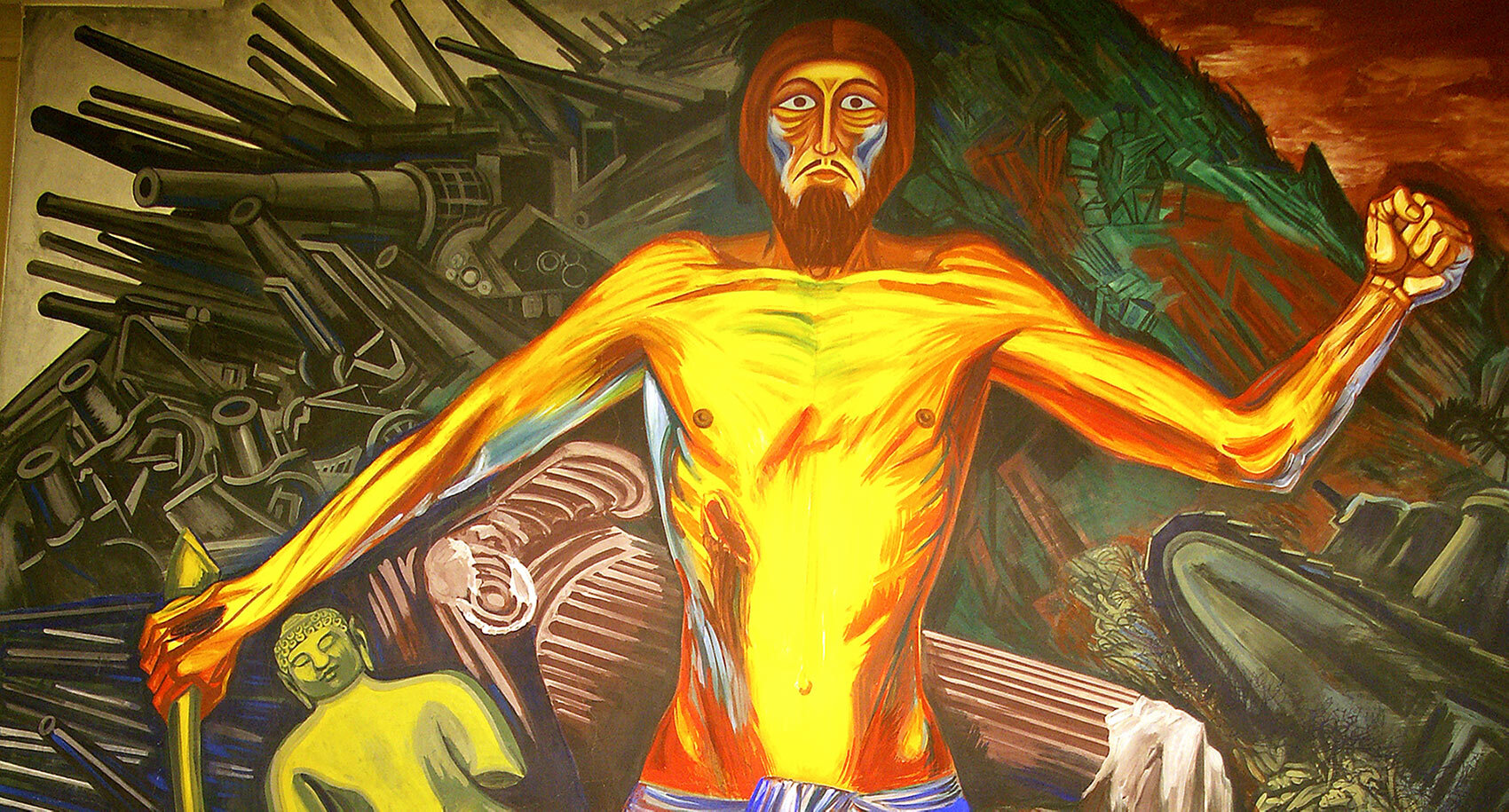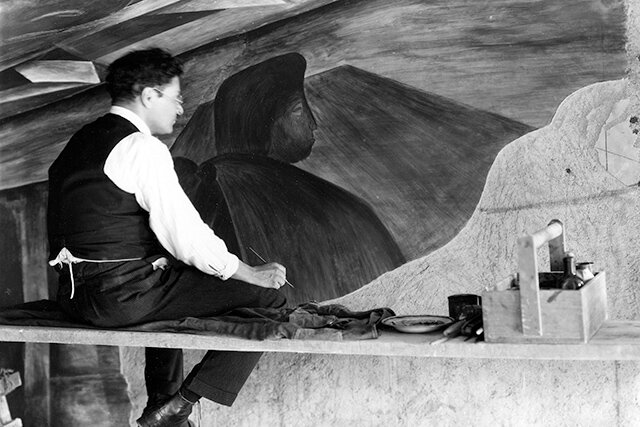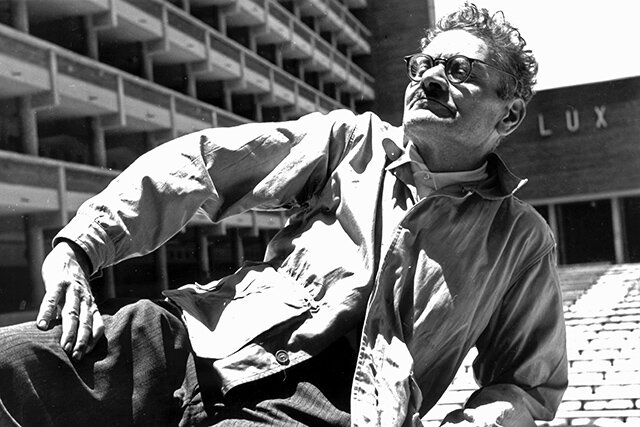Jose Clemente Orozco's Life and Times
Panel 19. Modern Migration of the Spirit - The Epic of American Civilization by José Clemente Orozco
“Orozco: Man of Fire is a remarkable film that serves as an indispensable guide to the extraordinary life and work of the Mexican muralist José Clemente Orozco. It is a must-see for anyone interested in the history of Mexican art and culture.”
INTRODUCTION
The life of Mexican muralist José Clemente Orozco (1883-1949) is one of the great, untold stories of modern art—filled with drama, adversity and remarkable achievement. He survived the loss of his left hand and destruction of his early work by U.S. border agents, and witnessed the carnage of the Mexican Revolution and turmoil of the Great Depression in America. A gifted easel painter, Orozco was first and foremost a public artist whose greatest achievements were murals created not for individual patrons but for the whole society.
BIOGRAPHY
Orozco was born in a provincial town in Mexico, but grew up in the hurly-burly world of downtown Mexico City at the turn of the century. He studied at a classical art academy and learned as well from the printmaker José Guadalupe Posada’s vivid art of the street. As a young boy Orozco displayed remarkable talent, but only after he lost his left hand in a tragic accident was he able to devote himself to his true vocation as a painter.
He came of age during the Mexican Revolution in which one million lost their lives. Due to his handicap, he escaped conscription and became a cartoonist, drawing biting social satires for opposition newspapers. Orozco’s first solo exhibition was attacked by the critics, and like many other Mexicans, he fled north, seeking better opportunities. At the Texas-Mexico border, most of his paintings were seized and burned by customs agents who knew nothing about the modern art movement. Orozco persevered, but was forced to make a living painting cinema posters and plastic dolls.
Back in Mexico in the early 1920s, Orozco was one of the first to paint public murals sponsored by the new revolutionary government. His early murals were vandalized by an angry mob, but he went on to explore the upheaval of the times in a daring series of frescos. He later returned to the United States, where he lived through the great economic “Crash” and lived in California, New York and New Hampshire. Orozco spent ten years in the United States, where he painted four major murals as well as hundreds of easel paintings and graphic works. He challenged stereotypes of Mexican art as folkloric, exotic and social realist, and became a vital member of the New York art scene. During his years in the U.S., Orozco faced episodes of censorship, but transcended cultural and language barriers to become a pioneer of the public arts movement of the 1930s-40s.
When Orozco returned to Mexico, he was a mature artist of international renown. Orozco decorated many of Mexico’s most important public buildings, including Mexico City’s Palacio de Bellas Artes, Suprema Corte de Justicia, Templo de Jesus el Nazareno and the Escuela Normal de los Maestros. In Guadalajara, he painted murals in the Palacio Municipal and Universidad de Guadalajara. At the city’s Hospicio Cabañas, he painted the Man of Fire mural cycle, considered the Sistine Chapel of the Americas. Orozco completed his last fresco less than a month before he died in his sleep of heart failure at the age of 65. In the fifteen years between his return to Mexico in 1934 and his death in 1949, his painting demonstrated a daring formal and thematic progression of historical, allegorical and abstract compositions.
THE MEXICAN MURAL MOVEMENT
José Clemente Orozco and his colleagues Diego Rivera and David Alfaro Siqueiros revived the monumental fresco painting of the Italian Renaissance, infusing it with modern themes and forms. They became the most famous proponents of a public arts movement that began in the1920s when the newly installed revolutionary government of Mexico began a program of commissioning artists to paint murals in public buildings. Mural painting would be a monument to the Mexican people and form of popular education, a history book for all to see. The images and messages of the murals became key ingredients in the evolving definition of Mexicanidad, Mexican national identity. The heroism of the Mexican Revolution, the spirituality of native cultures and the rejection of foreign domination were themes codified on public walls and integrated into the national consciousness.
THE IMPACT OF THE MEXICAN MURALISTS ON ART IN AMERICA
The mural movement Orozco, Rivera and Siqueiros launched in Mexico in the 1920s captured the imagination of Depression era America. By the 1930s all three were living and working in the United States. When Franklin Delano Roosevelt put American artists to work on public walls during the 1930s, he looked to the Mexican mural renaissance as a model. The result would be the WPA Arts Program, which put thousands of artists on the government payroll at workers salaries, as in Mexico, and lead to the creation of hundreds of murals around the country.
Orozco played an important part in the broad cultural exchange between the United States and Mexico in those years, influencing such diverse American artists as Thomas Hart Benton, Jackson Pollock, Isamu Noguchi, Jacob Lawrence, Aaron Douglas and Philip Guston. His modernism bridged the epic style of the “Escuela Mexicana” and post World War II abstract expressionists. During the 1960s-70s, the community mural movement that blossomed in African American and Latino neighborhoods drew inspiration from Orozco’s groundbreaking vision of the role of art in society. Today artists on both sides of the border continue to embrace the innovative and independent spirit of his art.




